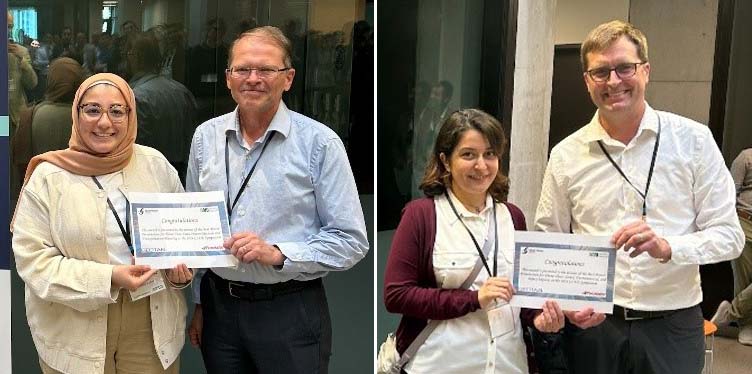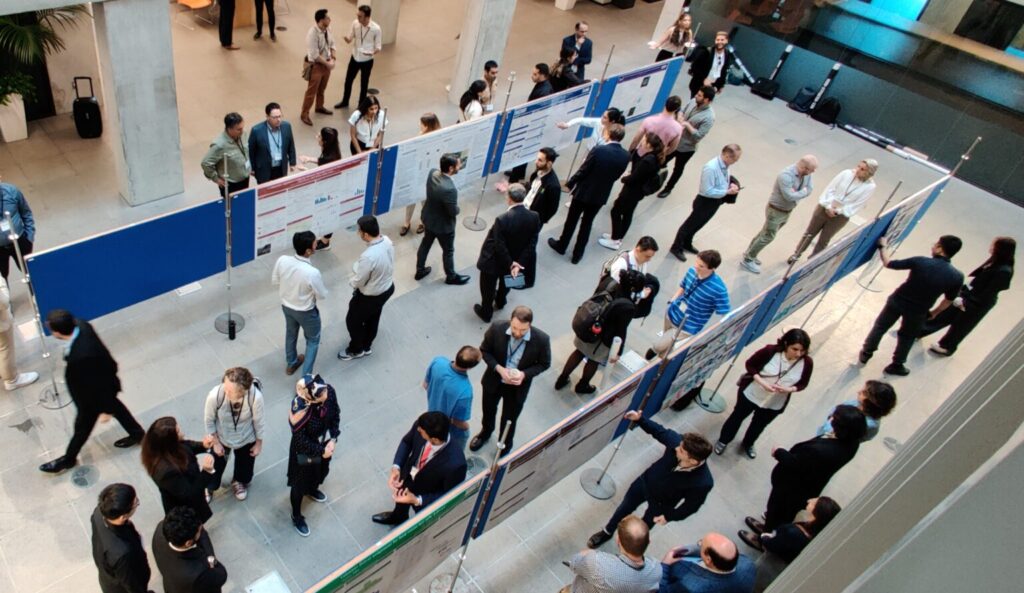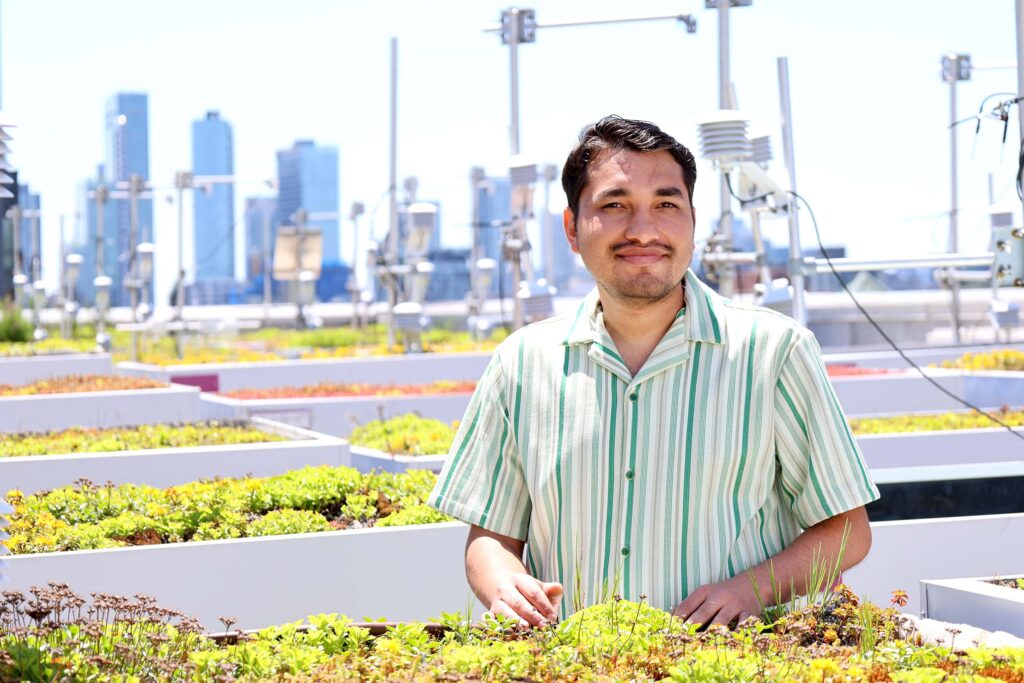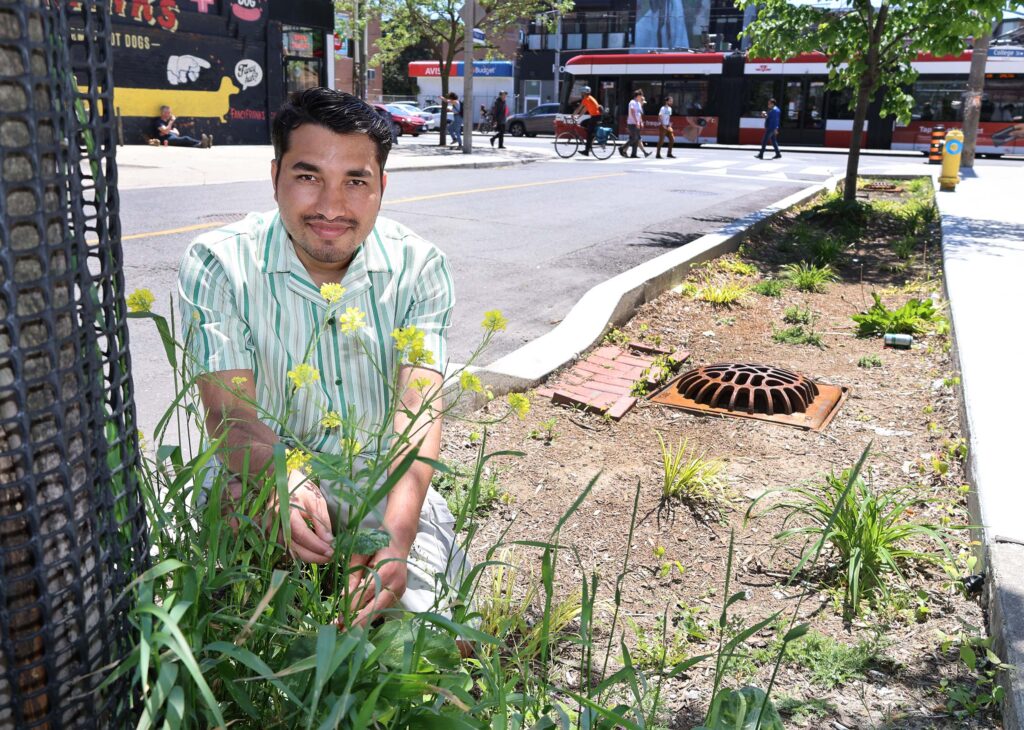
The Mobility Network announced the winners of their 2024 Five-Minute Thesis Competition (5MT) at a ceremony Tuesday, June 11.
Presentations were ranked based on their creativity, clarity of research topic and methods, and ability to present complex ideas under five minutes. Two CivMin professors judged the videos, awarding points out of a total possible of 14.
Winners include:
- Mwendwa Kiko (PhD student – first place award): ‘Travel Demand Modelling & Socio-Economic Evaluation of Infrastructure Projects’
His specialization is travel demand modelling, and socio-economic evaluation of infrastructure projects. Kiko is supervised by Prof. Eric Miller. - Farah Ghizzawi (PhD student – second place): ‘Developing a Parking Choice Model using the Fusion of Limited Data’
Her research focuses on modelling the parking choice of urban freight vehicles. Ghizzawi is supervised by Prof. Matthew Roorda. - Weaam Jaafar (PhD student – third place): ‘Capturing the Impacts of Construction Activities Using a Network of Low-Cost Sensors Placed on Residential Balconies’
His research aims at working with a community as citizen scientists to assess the contribution of construction sites to the air quality of the community. Jaafar is supervised by Prof. Marianne Hatzopoulou.
The Mobility Network Five-Minute Thesis Competition (5MT) is made possible thanks to the financial support of Alex Ariza (EngSci 0T9, CivE MASc 1T1).
The winning videos will be posted online by the Mobility Network in the near future.
CivMin undergraduate students
- ONTARIO CHAPTER, AMERICAN CONCRETE INSTITUTE AWARD: On the recommendation of the Chair. Awarded to a graduating student, or team of students, with the most meritorious final year thesis and/or capstone design project related to the use of concrete.
CIV498 Capstone/ Reinforced Concrete Bridge Design – Angela Abdullahi, Adneen Mir, Jihwan Shim - CENTENNIAL SENIOR PROJECT AWARD: Awarded for outstanding IV year thesis or capstone design project in each program. Successful student or team of students must be registered in the Faculty.
MIN476/ Mineral Design Project/ Title: “Yanahuanca Gold Project – Mining Component of Pre-feasibility Study”/ Aluong Jongkuch,
(Belinda) Ayuan Wang, Evan Beri, Grant Liao
CIV498/ Civil Engineering Design Project/ Title: “88 COLLEGE ST. RETROFIT GM&S BUILDING SCIENCE” / Nile Gulistani, Meg Melendres, Liah Scott , Eva Shah
- ONTARIO PROFESSIONAL ENGINEERS FOUNDATION FOR EDUCATION GOLD MEDAL FOR ACADEMIC ACHIEVEMENT: Jeff Chen
- W.S. WILSON MEDAL: Jeff Chen (CivE) and Evan Beri (MinE)
- OTTO HOLDEN SCHOLARSHIP: Jeff Chen.
June 12, 2024 | Radio-Canada (CBC)
June 2024 | TIME
June 11, 2024 | The Agenda, TVO
June 7, 2024 | Global News

Two CivMin graduate students have won for their individual poster and presentation at the third annual symposium for City Logistics for the Urban Economy (CLUE). Farah Ghizzawi and Sara Torbatian, both PhD students in the Department of Civil & Mineral Engineering at the University of Toronto, were recognized as the top presenter for their respective theme.

Ghizzawi, studying under the supervision of Prof. Matthew Roorda, was the best presenter for her theme, Data-Driven Methods and Transportation Planning with poster title “Developing a parking location choice model using the fusion of limited data: The case of commercial vehicles in Toronto”. The poster presents the research framework of developing a parking location choice model for commercial vehicles using the fusion of limited data. The research is intended to show that data fusion could be a promising approach to tackle data challenges in modelling freight travel activity, specifically parking patterns. Various data sources are integrated to identify factors influencing parking decisions. GPS data is utilized to map travel routes, allowing us to deduce stop locations, durations, frequencies, and trip attributes. Parking location characteristics are inferred from data detailing the features of parking infrastructure. Industry sector information is also incorporated to infer commodity and/or services typologies. She joined Professor Matthew J. Roorda’s team at the University of Toronto in September 2020. Her research focuses on modelling the parking choice of urban freight vehicles and evaluating parking management policies. Farah worked as a transport modeller for six years in a regional engineering consulting firm based in Beirut. Farah has a bachelor’s degree in civil engineering and a master’s degree in engineering management from the American University of Beirut.

Torbatian, studying under the supervision of Prof. Marianne Hatzopoulou was the best presenter for her theme, Social, Environmental, and Safety Impacts with poster title “Implications of Freight Electrification Scenarios for GHG Emissions, Air Quality Health and Environmental Justice”. This study explores the potential co-benefits associated with electrification, one important pathway toward decarbonization of freight. In this study, a detailed assessment of freight electrification scenarios (including light, medium, and heavy-duty trucks) was conducted from different perspectives including air quality, health, and environmental justice, using the Greater Toronto and Hamilton Area (GTHA) as a testbed.
CLUE hosted a vibrant knowledge café and poster competition to showcase the past year’s research. This symposium, organized with the Smart Freight Centre—a collaboration of researchers from McMaster University, Toronto Metropolitan University, University of Toronto, York University, and stakeholders from the Greater Toronto and Hamilton Area (GTHA)—attracted over 70 participants from academic, the public sector, and the private sector.
The symposium featured two sessions with four poster themes. Each theme had ten posters, making it 40 posters in total. The themes were:
- Electrification and Emissions. Click here to view the posters of this theme
- Data-Driven Methods and Transportation Planning. Click here to view the posters of this theme
- Social, Environmental, and Safety Impacts. Click here to view the posters of this theme
- New Technologies and Operational Models. Click here to view the posters of this theme

June 4, 2024 | Nature Sustainability

CivMin PhD student Bhabishya Khaniya has been selected as one of the recipients of the 2023-2024 Vanier Canada Graduate Scholarships (Vanier CGS) awarded by the Natural Sciences and Engineering Research Council (NSERC).
Providing $150,000 in funding over three years, the scholarship recognizes PhD candidates at Canadian universities who demonstrate excellence in the areas of leadership, research impact and academics. Khaniya is supervised by Professor Jennifer Drake, who recently left CivMin to take a position at Carleton University, and Dr. Chris Szota and Professor Tim Fletcher from the University of Melbourne. His research in the area of bioretention systems complements his supervisor’s expertise in green stormwater infrastructure and urban waterway ecosystem management.
The Vanier CGS program plays an important role in fulfilling the Government of Canada’s Science and Technology strategy to promote the development and application of leading-edge knowledge, support the development of a world-class workforce, and attract and retain the world’s top graduate students. Each year, these highly prestigious scholarships are offered to doctoral students who have demonstrated strong leadership skills and a high standard of scholarly achievement in graduate studies in the social sciences and humanities, natural sciences and engineering, and health.
CivMin had a chat with Khaniya to talk about becoming a Vanier Scholar and more.
Please tell us a little about yourself.
Hello, my name is Bhabishya Khaniya, a PhD student co-supervised by Professor Jennifer Drake from the University of Toronto (now at Carleton) and Professor Chris Szota, and Professor Tim Fletcher from the University of Melbourne. I started at U of T in Fall 2022. I am doing a joint PhD with the University of Toronto and the University of Melbourne.
What’s your area of research?
I’m studying bioretention systems which are a type of green stormwater infrastructure systems that help to manage stormwater runoff generated from impervious areas. These structures protect urban waterway ecosystem and help to make cities more climate resilient by reducing floods, replenishing groundwater, and also mitigating urban heat island effects. There has been growing interest in installing bioretention systems in cities especially around the road right-of-way areas to manage stormwater runoff at the source itself. But the challenge is that not all these systems that cities have installed are performing very well. What are seeing now is a lot of problems in terms of design, construction, and maintenance of these systems, and as a result, these structures aren’t performing as they should. In my research, I’m studying the failure mechanisms of these structures to identify bioretention designs and configurations that are least susceptible to failures and are universally resilient in different climates and communities.

Can you give us a very simple idea of what one of these structures would look like or how it works?
Bioretention systems are soil-plant-based systems. The main components of bioretention systems are vegetation, soil, and hydraulic flow structures such as inlets, outlets, and underdrain pipe. The vegetation at the top is followed by a soil layer usually called filter media layer. The filter media that we use in bioretention systems are engineered soil media. It has a sandy texture with high hydraulic conductivity and consists of several other amendments that help to retain the pollutants of the stormwater runoff. When it rains on impervious surfaces, a significant amount of runoff is generated. Because the soil here is pervious, water can quickly infiltrate through these systems, and water gets stored in the pore spaces. As this water percolates through the soil, it will undergo natural treatment processes and help to remove the pollutants of the stormwater. Some of the pollutants such as nitrogen are removed by plant uptake. In this way mimicking the natural hydrological processes, bioretention system helps to reduce the volume, peak flow rate, and pollutant concentration of the stormwater runoff and protect the urban waterway ecosystem from degradation. The vegetation component is important as it provides ecosystem services benefits of urban cooling and biodiversity protection.
Are you doing this right now, in full-scale or a smaller-scale setups?
Bioretention structures have been installed in road right-of-way areas by the City of Toronto. I have installed monitoring setups in several of these sites here in Toronto that include soil moisture, and water level sensors to collect performance data and data on operational conditions. I have also collected soil samples to analyze the hydrologic and geotechnical properties of the soil.
The performance in terms of volume of water flow and this sort thing?
Yes, exactly. In terms of performance, we are looking at whether or not these structures are managing volumetric runoff and also providing water quality benefits.
You’ve been at this work for two years already. And how much longer do you think, I
Yes, it has almost been two years, and things are going quite well. Right now, I’m mainly focused on collecting data from my sites here in Toronto. Once I finish gathering data here, I’ll be heading to Melbourne, Australia to collect a similar set of data from bioretention sites there. The goal is to gather information on the performance and functionality of bioretention systems in different climates and geographical locations to establish a universal failure mechanism.
How did you get into this area? How did your academic and research path take you here?
I did my undergrad in civil engineering back in Sri Lanka (I am originally from Nepal) and that is where my interest in water resource engineering began. I enrolled in apprenticeship programs, diving into research related to low-impact development and sustainable urban drainage systems. I then pursued a master’s in sustainability management at the University of Waterloo, where I gained deeper knowledge about sustainable water resource management for creating a climate-resilient environment. Following my passion for green infrastructure solutions, I joined the Department of Civil and Mineral Engineering at the University of Toronto to continue working on low impact development and sustainable water resource management systems.
What attracted you to the University of Toronto?
Well, the University of Toronto is one of the most reputed universities in the world with its rich academic and research history, and I’m so proud to have been admitted to UofT. I was especially impressed with the research facilities and the work being carried out in Professor Drake’s lab. Another thing that drew me here is the campus’s location. Being in Toronto, a city that’s so vibrant and beautiful, feels absolutely amazing.
You have some big news too. It’s been announced that you’re now a Vanier Scholar. Tell us how that feels to be given this award… and congratulations!
It was unbelievable news for me. The first time I saw the email saying I was awarded the Vanier, it was like a dream come true! I felt this incredible rush of joy and gratitude. It truly recognized all the hard work I’ve put in and everything we’re striving to achieve. Now, I feel an added responsibility to carry out research that can solve the current issues in implementing green stormwater infrastructure solutions for climate-resilient cities. This scholarship has motivated me even more to tackle research problems that can make a real impact on people’s lives now and in the future. This award wouldn’t have been possible without the amazing support of my supervisors, Professors Drake, Szota, and Fletcher. I am deeply grateful to them for their encouragement and guidance.
By Phill Snel
Chen is awarded the Governor General’s Silver Medal and the John Black Aird Scholarship

Jeff Chen, a fourth-year civil engineering student in the Department of Civil and Mineral Engineering (CivMin) at the University of Toronto, has won the Governor General’s Silver Medal and the John Black Aird Scholarship. The Silver Medal is awarded to an undergraduate student who achieves the highest academic standing upon graduation from a bachelor’s degree program. There are three silver medals awarded at the University of Toronto. This is the second year in a row that an Engineering student has received this distinction.
“Since receiving word of these accolades, my emotions remain unchanging—an enduring sense of gratitude for my peers and professors, embedded in all the experiences we’ve shared,” reflects Chen. “These accolades will remind me that my past four years at U of T Engineering will always be a defining chapter in my life.”
The Governor General’s Academic Medal was first awarded in 1873 by the Earl of Dufferin, and has since become one of the most prestigious awards that a student in a Canadian educational institution can receive.
The John Black Aird Scholarship was established in 1996 in memory of the Honourable John Black Aird, former chancellor of the University of Toronto and Lieutenant-Governor of Ontario and is awarded to the most outstanding student graduating from an undergraduate program. The winner of this award is selected from among those students who are nominated by their divisions for the Governor General’s Silver Medals.
Over the course of his four years of study in CivMin at U of T, Chen achieved an incredible 100% mark for 17 of his 46 courses, giving him a 96.5% average overall. This straight-A student has also garnered other awards as recognition for his academic prowess:
- Ontario Professional Engineers Foundation for Education – Gold Medal for Academic Achievement: awarded for the highest weighted cumulative average percentage. Honours required.
- Otto Holden Scholarship: Highest aggregate mark in two of all Hydraulic engineering subjects in the course, require honours in IV year. (Civil: CIV340H1, CIV250H1. Mechanical: MIE312H1, MIE414H1)
- W.S. Wilson Medal: Highest standing in IV year. Honours required.